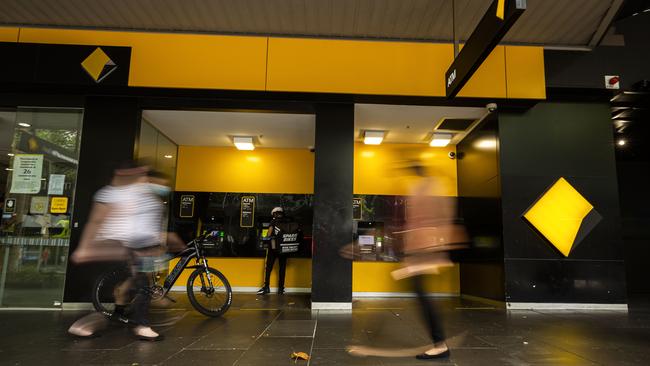Banks under pressure to live up to high hopes
Earnings reports and capital management will need to impress investors to get positive share price reactions this earnings season.

Bank earnings reports and capital management will need to impress investors to elicit positive share price reactions this earnings season, with Commonwealth Bank in the spotlight when it reports on Wednesday.
The S&P/ASX 200 Banks index fell 1.5 per cent on Tuesday, as the broader market fell 0.9 per cent after bouncing almost 6 per cent from a two-month low to a fresh 11-month high early this month.
After falling 42 per cent in the sharemarket sell-off early last year, the S&P/ASX 200 Banks index as of Monday had risen 70 per cent from its March 2020 low, versus 51 per cent for the broader market.
The Banks index rose 22 per cent in the past three months, versus 9 per cent for the ASX 200, as an improving economic outlook and higher bond yields triggered a rush to value stocks globally.
Citi’s Brendan Sproules expects CBA to beat the consensus estimate by about 2 per cent, with a cash net profit after tax of $4.001bn on better net interest margins and bad and doubtful debts — driven by a sharp recovery in employment, lowering loan losses.
Australia had in aggregate recovered all the lost jobs due to COVID-19 and the bank’s estimates of their loss estimates will benefit from a sharp fall in deferred loans and reduced credit stress across the economy, he notes. Perhaps more importantly for the share price after such a strong run is Citi’s forecast that CBA’s dividend will be 15 per cent more than the market expects.
But even with those expected beats, Citi’s rating remains neutral, with a target price of $82.50.
CBA’s large skew to well-collateralised residential mortgages will have given it some insulation from bad debts after the COVID-19 recession, and its higher regulatory capital position relative to peers will provide a buffer to losses and support for lending growth. But with its shares trading at 1.6 times book value, Citi’s Sproules cautions that the longer-term potential returns for CBA may already be reflected in the share price.
“Strong rallies running into reporting season often lead to a binary outcome with regards to share price performance,” he says. “This leads us to a key question heading into reporting season — will February be D-Day for bad debt expectations?”
The banks rallied strongly last year as a “value rotation” globally got carried along in Australia by a rapid rundown of deferred loans, vaccine hopes and reopening signposts, a remarkable recovery in the job market and a rocket under asset prices courtesy of central banks.
“While all these factors point to lower default probabilities and loss outcomes, investors will want to see the proof in the print,” Sproules says.
“More so, given the Australian Prudential Regulation Authority’s green light to dividends and a world devoid of growth, investors will want to see lower bad debts in the form of a dividend cheque.”
Intriguingly, Suncorp reported a first-half cash net profit after tax of $509m on Tuesday. That was a massive 11 per cent above the company-compiled consensus of $460m, driven by much-better-than-expected net interest margins and bad and doubtful debts in its banking division.
Suncorp also reported a first-half dividend of 26c a share, versus expectations of 22c.
How much of a read through that has for the banks will be borne out in results from CBA and Bendigo and Adelaide Bank as well as trading updates from ANZ, Westpac and NAB.
But even with Suncorp’s “unstretched” valuation of 14.9 times Goldman Sachs’ forecast for 2021-22 earnings per share, its shares more than halved a 6.4 per cent intraday rise on Tuesday.




To join the conversation, please log in. Don't have an account? Register
Join the conversation, you are commenting as Logout